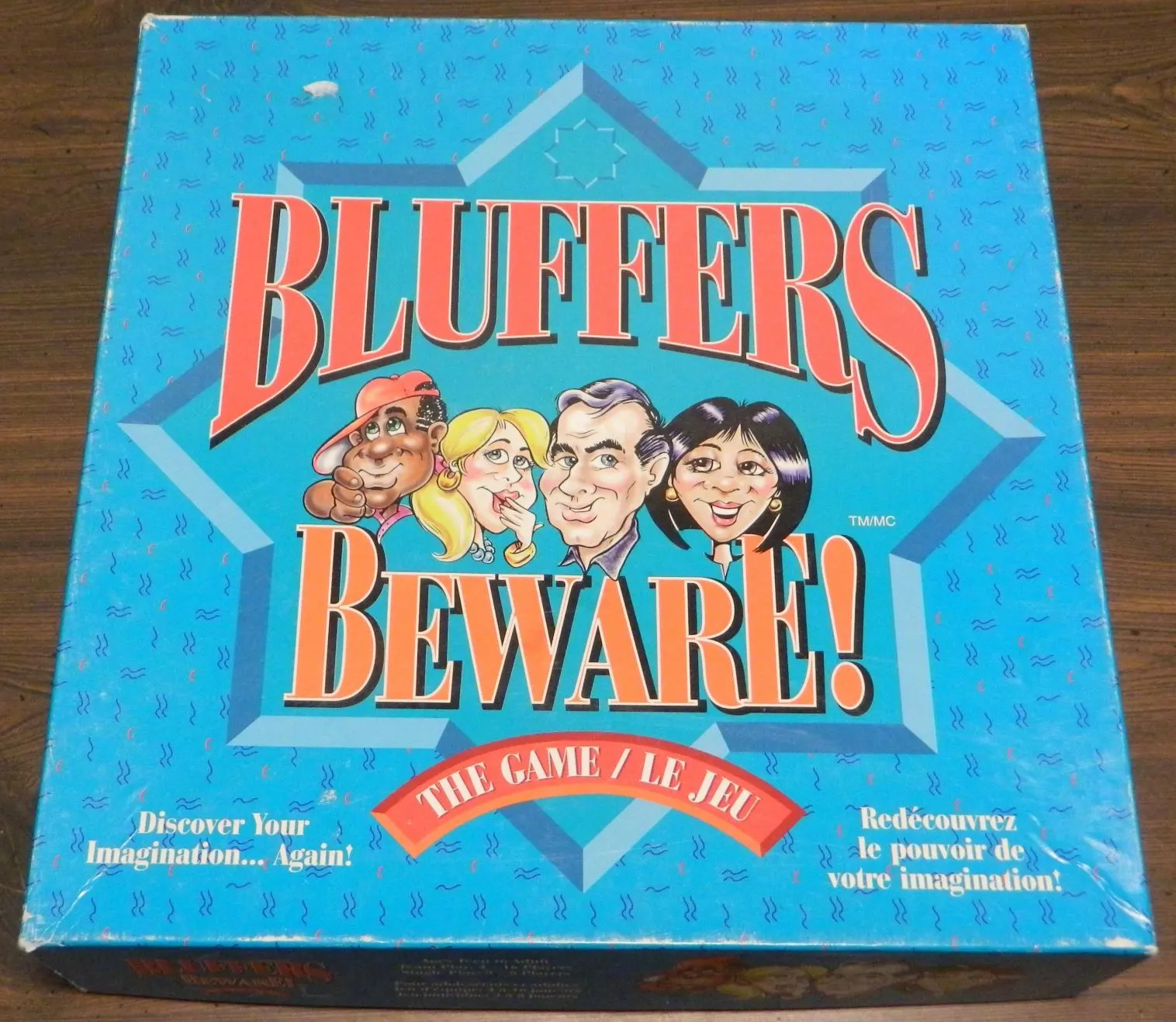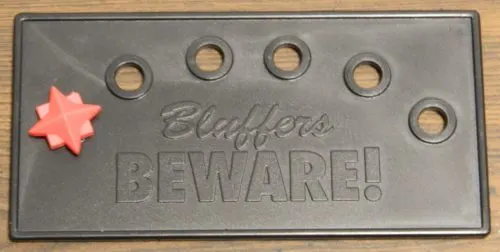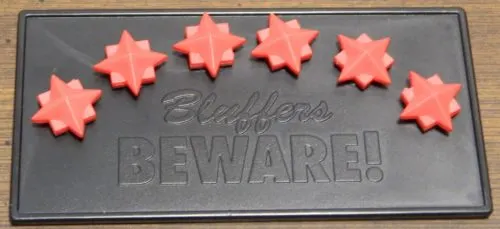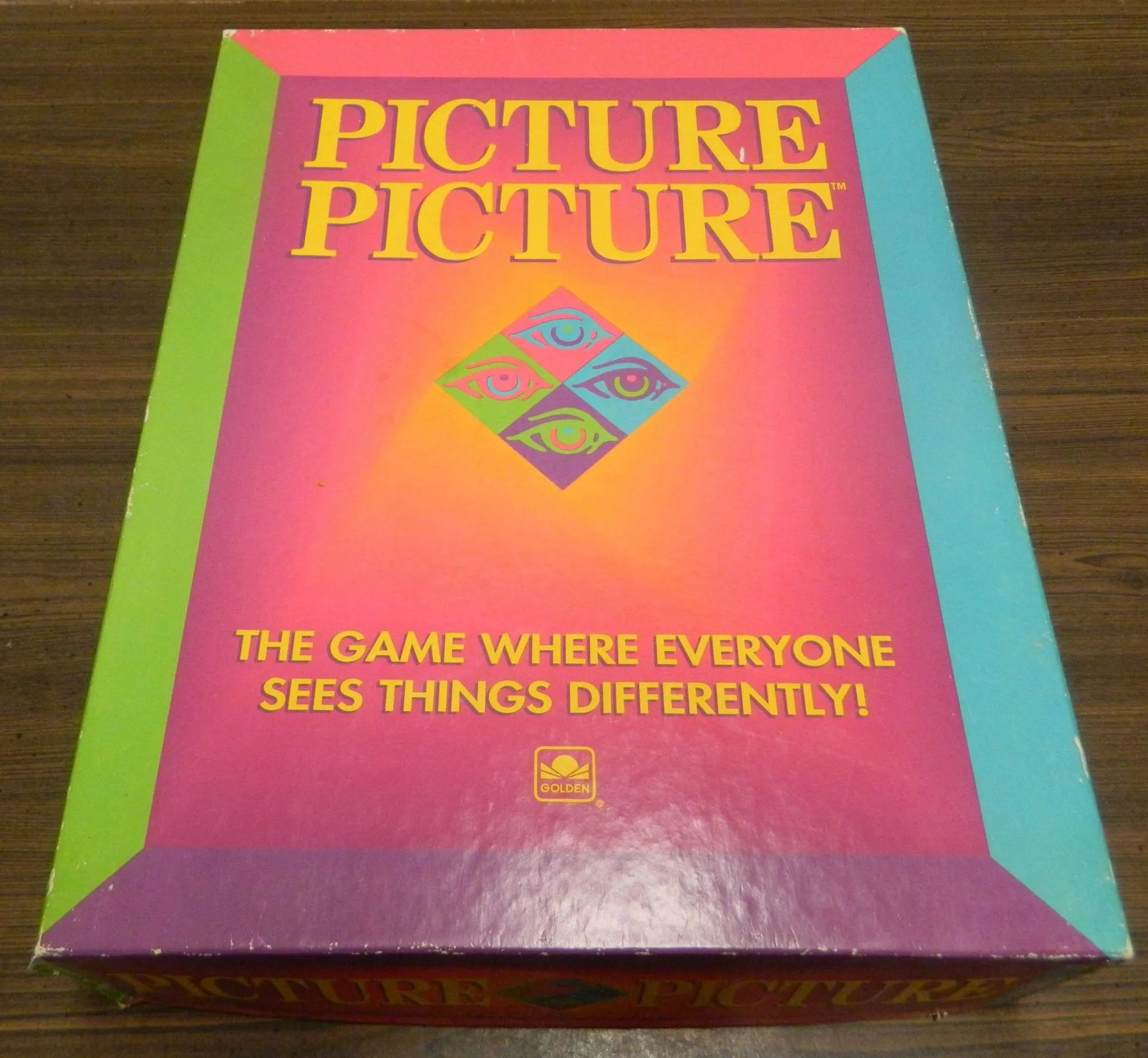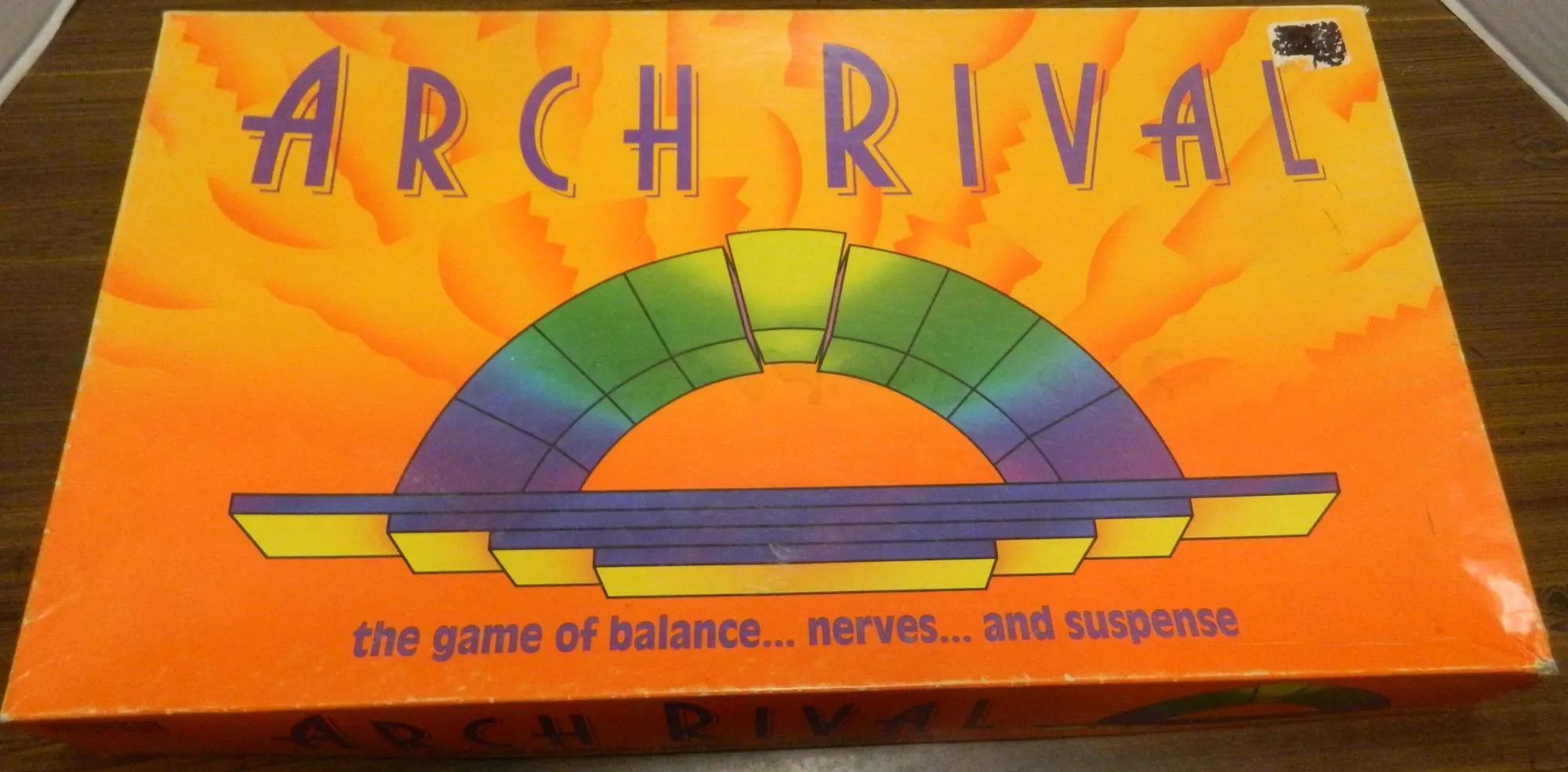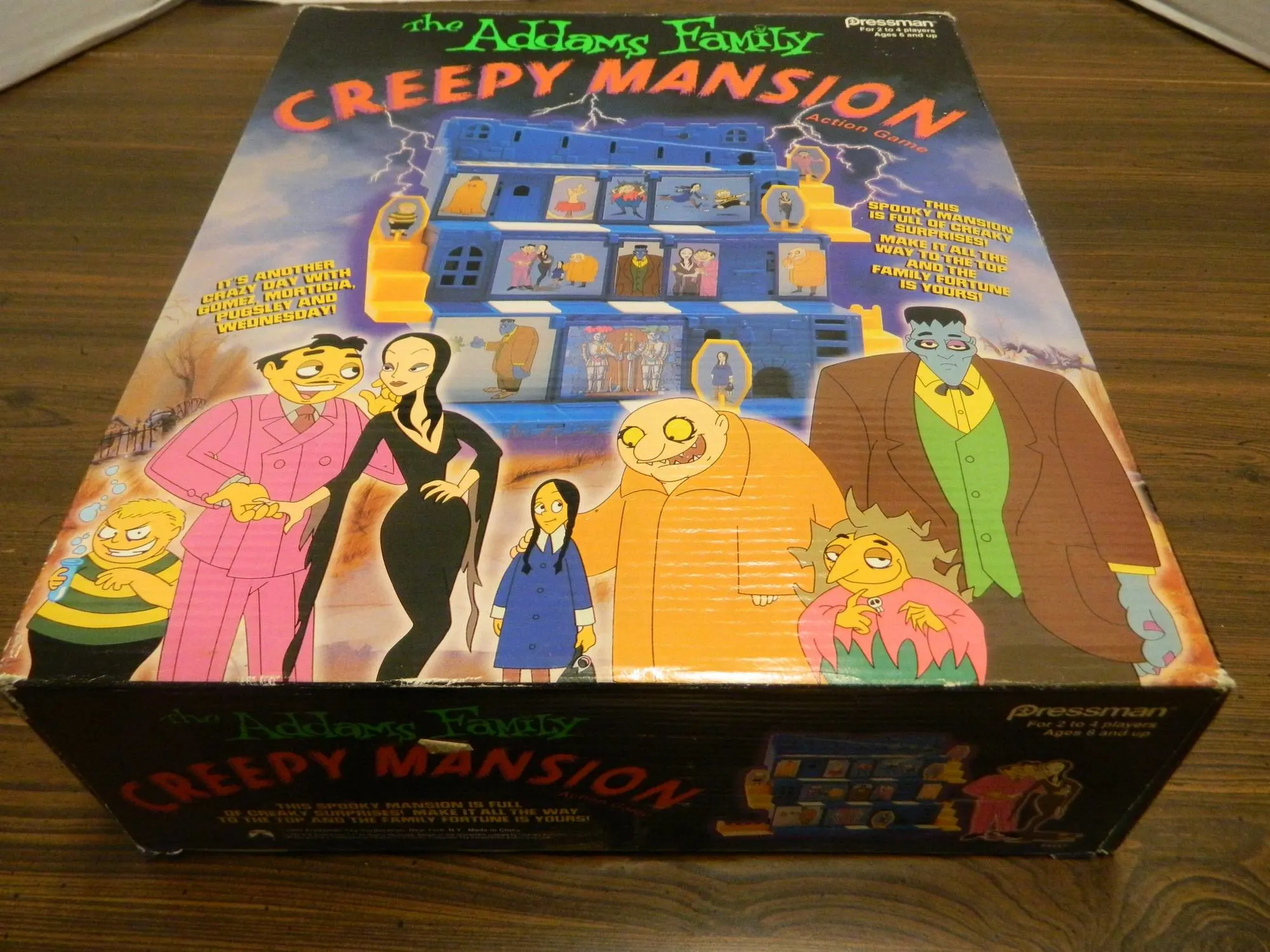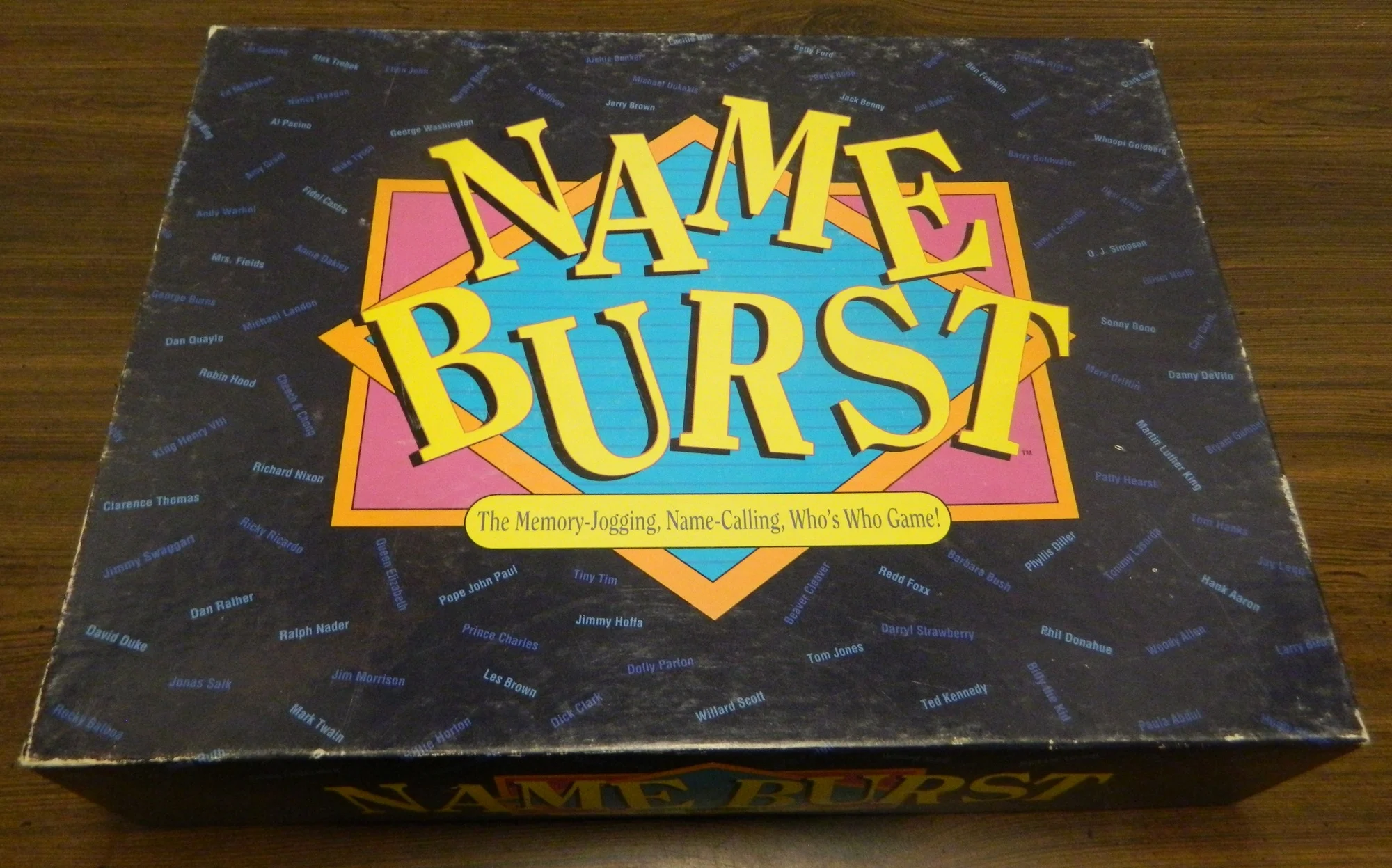Here on Geeky Hobbies we are big fans of the game Balderdash. The game has been around for many years especially since it is based around the public domain game Dictionary. The premise behind the game is quite simple as you are given a word and players make up their own definition for it trying to trick the other players. Over the years there have been many games utilizing this premise with most focusing on words. There have been a few other implementations though with inventions in particular being pretty popular. In fact we have already reviewed two other games that have taken the Balderdash mechanic and applied it to inventions: The Invention Game and The Game of Inventions. Today I am looking at another called Bluffers Beware which was released back in 1992. Bluffers Beware doesn’t revolutionize the Balderdash genre of games in any significant way, but it is a solid party game that anyone can enjoy.
How to Play Bluffers Beware
Setup
- Set up the Display Stand and place it in the middle of the table.
- Choose one of the boxes of cards and place them on the table.
- Each player is given a Scoring Chip.
- Place enough I.D. Chips on the table for each player minus one. One of the I.D. Chips must be the Truthteller Chip.
- Randomly choose a player to be the first Guesser.
Playing the Game
To make the rest of these instructions easier to follow there are three different types of players in the game:
- The Guesser is the player that is trying to guess which of the other players is telling the truth about the object on the display card.
- The Truthteller must use their own words to give a correct description of the object.
- Bluffers will give a fake description of the object hoping to fool the Guesser.
The game is played over a number of rounds. To begin the round all of the players except for the Guesser must determine their role for the round. Each of these players will randomly choose one of the I.D. Chips which will give them their role for the round.

This player drew the Truthteller I.D. Chip so they will have to give the actual description to the Guesser.
One of the players other than the Guesser will choose one of the cards from the box and places it in the Display Stand. The card is placed so the picture is visible and the description on the back is hidden behind the sliding door.
All of the players other than the Guesser will look at the description of the object from the back of the card. The Truthteller must remember this description as they will have to give the same description in their own words. The Bluffers need to come up with a description that they think the Guesser will think is more convincing than the actual description. When coming up with their bluffs they cannot use any of the words from the real description that are underlined. If either the Truthteller or Bluffers break the rules a new card will be drawn and the Guesser will get another turn.
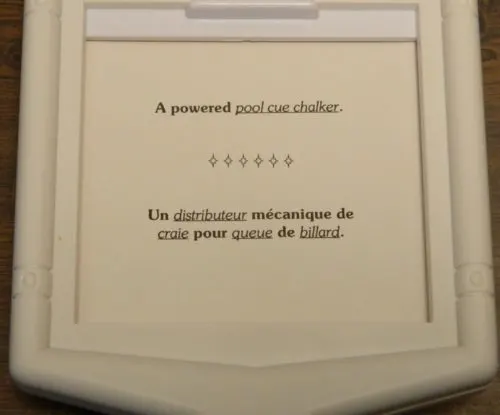
Here is the description for the card chosen for the current round. The displayed object was “A powered pool cue chalker”. The Truthteller has to give this description (in their own words) to the Guesser. The Bluffers can make up whatever description they want that doesn’t use the words “pool cue chalker”.
The player that is clockwise to the Guesser will give their description first followed by the rest of the players in clockwise order.
Once all of the descriptions have been given the Guesser will try to guess which player was telling the truth. Points will be scored based on the player that the Guesser chooses.
- If the Guesser chooses correctly they and the Truthteller will receive one star which they will place on their Scoring Chip.
- If the Guesser chooses incorrectly the Bluffer whose description was chosen will receive two stars.
After stars are awarded the role of Guesser will pass to the next player clockwise.
End of Game
The first player to earn six stars wins the game. If there is a tie the game continues until one player has more stars than the rest of the players.
Team Game
Instead of playing a solo game players can choose to play the team game. Most of the rules are the same as the main game. The differences are noted below.
In the team game players will divide into two or more teams. If there are two teams, in each round one team will be the Guessers and the other will be the Bluffers. These roles will alternate between rounds. If there are three or more teams one team will be Bluffers while the rest are Guessers. The role of Bluffers will rotate clockwise each round.
All members of the Bluffing team will choose one of the I.D. Chips making sure one player draws the Truthteller Chip. The chip each player takes determines their role in giving descriptions. Before giving out their descriptions the members of the Bluffing team can discuss strategy.
Each Guessing team will then decide which description to vote for.
- If the Guessing Team guesses correctly they will receive two stars.
- If they guess incorrectly the Bluffing team will receive one star.
The first team to earn six stars wins the game. The tie-breaking rules are the same as the normal game.
My Thoughts on Bluffers Beware
Anyone familiar with Balderdash or one of the other similar bluffing games are likely to already have a good idea of what it is like playing Bluffers Beware. It is pretty evident that it borrows heavily from this genre of games. The main difference is that words have been replaced with inventions. Each round will feature one invention and the players have to try and decipher the invention’s original purpose. Players will then score points based on whether they guess the correct purpose of the invention, and whether they can trick the other players into guessing their made up description.
There is one area where Bluffers Beware does distinguish itself some. In most of these types of games one player will be the reader while the rest of the players submit their own responses and make a guess at the actual correct response. This is a little different in the team game, but in Bluffers Beware only one player is a guesser while the rest of the players will give answers. Players will draw tokens which will determine whether they have to tell the truth or whether they will lie. Where this becomes interesting is that all of the players that are giving descriptions get to look at the actual answer in order to craft their answers.
I honestly had some mixed feelings about this mechanic. On the positive side knowing what the actual answer is makes it easier to craft an answer that will be believable next to the correct answer. With this information you can craft a similar answer making sure you don’t use the underlined words. Otherwise you could come up with something just as wacky/stupid as the actual purpose of the invention. This is a really interesting twist that I have never really seen used in this genre before. This does a decent job distinguishing the game from other similar games.
Probably the reason that this mechanic hasn’t been used in other games though is the fact that it limits the number of guessers. In other games all of the players besides the reader can submit a guess as they don’t know the actual answer. With the bluffers being able to see the correct answer though they obviously can’t guess. This creates a divided experience for all of the players. While the players come up with answers the Guesser has nothing to do. After the answers are revealed though the other players have nothing to do. This leads to some slow points in the game where you are forced to wait for the other players.
This mechanic also creates a potential problem for the game. The Truthteller knows what they have to say, but the Bluffers can basically come up with anything. This creates problems if two players are on the same wavelength. This might not come up a lot, but it actually happened in one of the games that I played. Two players had the exact same bluff in mind and when it came time for the second player to say their description they had nothing to say which kind of spoiled that the other player’s response was also a bluff. Unless you can think on your feet the second player is unlikely to come up with a good response. For this reason it would actually be beneficial for the players that aren’t the Guesser to come up with a plan for their responses. This will force the Guesser to move to another room or they will overhear what the other players are discussing.
At the end of the day I don’t know whether I like or dislike the mechanic. On the positive side your opinion on it doesn’t really matter all that much. This is because if you don’t care for it you can easily ditch it and turn the game into a more traditional Balderdash experience. Just give the players some paper to write down their responses and you can turn the game into every other Balderdash style game. In fact this would basically turn Bluffers Beware into The Invention Game. For this reason I personally found Bluffers Beware to be the better game as it offers more options along with some other things that I will talk about shortly.
So what were my thoughts on Bluffers Beware as a whole? I enjoyed my time with the game. It is far from revolutionary which should be obvious from the fact that I have played two other games with a very similar premise. If you are looking for a highly original game you are unlikely to find it with Bluffers Beware. This doesn’t mean that the game is not enjoyable. It features all of the elements from this genre of games that I find enjoyable. Trying to come up with bluffs to trick the guesser is as enjoyable as ever. There are likely to be some laughs based on the actual purposes and bluffs for the inventions as well. Basically if you enjoy a good bluffing game you likely will enjoy your time.
Bluffers Beware does share one of the biggest problems that plagues this genre though. Like most games from this genre some of the descriptions for the inventions can be quite specific and will be quite different from anything the bluffers could actually come up with. On their own these descriptions will stick out like a sore thumb. I do applaud Bluffers Beware as it allows the Truthteller to describe the actual answer in their own words which makes it a little easier to camouflage. In order to stand a chance of a player guessing one of your bluffs though you need to be willing to think outside of the box as an obvious answer is unlikely to cut it. Creativity is key to your success as a bluffer.
There is an amount of luck to the game as well. This comes from a couple different factors. First the card that is drawn when you are the Guesser is going to play a pretty big role in how easy it is to guess the correct answer. Based on some of the pictures it is pretty obvious what the correct answer is as either the actual answer makes sense or the Bluffers are unable to come up with a good bluff. Luck also comes into play in determining what role you get when you aren’t the Guesser. As these roles are randomly selected you could either be stuck as the Truthteller or a Bluffer. It is easier to score points as the Truthteller, but you can score twice as many points as a successful Bluffer. Because of this fact and just the nature of Bluffers Beware you need to approach the game where it doesn’t really matter who wins. It is the type of game that is just more enjoyable if you take it for what it is instead of worrying about who is going to win.
Bluffers Beware is at its heart a party game. Thus the game succeeds by making the game easy to pick up and play. The game has a recommended age of teen to adult which feels about right. Anyone who has played games like Balderdash could almost jump right into the game as the few differences are really easy to adjust to. Those who have never played Balderdash though should still learn the game pretty quickly as the mechanics are quite straightforward.
As for the length I thought it was too short. Now the length of the game is likely to depend pretty heavily on the number of players as well as their skill. If you only play with four or so players the game is likely to end pretty quickly. This is mostly due to the fact that you only have to score six points in order to win the game. The game could theoretically end in three turns. It is very likely to take longer than that, but a four player game could end with each player only being a guesser two or three times. Having more players should fix this as there will be more options to guess which should spread out the points more. With less players though I would recommend playing to more than six points though as the game is otherwise too short.
Finally I thought Bluffers Beware’s components were solid, but not spectacular. On the positive side I liked that the game includes 200 cards. Each card only features one invention, but you can still play 200 rounds without having to repeat a card. After playing each of the cards the game loses much of its replay value as once you are familiar with the pictures it will be much easier to guess the correct response. I thought the display stand was kind of nice as it lets the Guesser see the picture while the other players look at the description. Otherwise the rest of the components are pretty average. I do think the game could have done a better job with the I.D. Chips though as it is somewhat hard to see what they say unless you look at them at the right angle.
Should You Buy Bluffers Beware?
Ultimately Bluffers Beware is very similar to your typical bluffing game such as Balderdash. Basically most of the players make up a fake purpose for an invention while the Guesser tries to determine its true purpose. The one thing that is unique about Bluffers Beware is that all of the players that come up with responses can actually see the real answer and craft their lie around it. This is interesting as it allows you to create a better lie, but it also leads to the game moving slower as only one player is the Guesser each round. You could easily use the standard Balderdash rules though if you don’t like this element of the game. Ultimately Bluffers Beware is a fun party game even if it doesn’t really differ from most other similar bluffing games. The game suffers from the same issue as most of these games where it is sometimes hard to create a good bluff while also relying on a decent amount of luck.
My recommendation for Bluffers Beware comes down to your feelings towards the Balderdash genre of party games. If you don’t really care for Balderdash I don’t really see the game appealing to you. Fans of the genre should enjoy their time with the game though and should consider picking it up.
Buy Bluffers Beware online: Amazon, eBay
. Any purchases made through these links (including other products) help keep Geeky Hobbies running. Thank you for your support.

